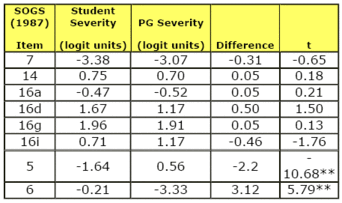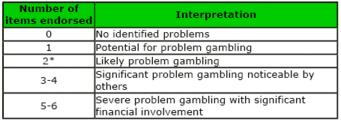As evidenced in numerous past WAGERs, researchers and clinicians regularly rely upon the South Oaks Gambling Screen (SOGS, Lesieur & Blume, 1987) to determine probable pathological gambling (PG) among subjects and patients. Since its introduction, the SOGS has proven reliable in both internal consistency and test-retest reliability among subjects suspected of having extensive (i.e., pathological) gambling problems. Because the SOGS’ items measure symptom presence rather than symptom type or severity, several studies question whether the SOGS can adequately discriminate risk across all ranges of gambling activity (e.g., Gambino, 1997); particularly subclinical populations. This week, the WAGER presents the results of a study by Strong, Breen, Lesieur and Lejuez (2003) that tested the reliability of SOGS responses among pathological and subclinical test subjects; based upon these results, this work supported a shortened version of the SOGS for use in subclinical populations.
Strong et al. administered the SOGS to three participant samples: two of U.S. college students (total N=861) and one of DSM-IV diagnosed pathological gamblers (69 men and 75 women). The first student sample was comprised of 487 (280 male) U.S. college students who gambled non-pathologically and the second sample was comprised of 374 non-pathological male participants participating in another gambling behavior study. Most student participants (53.2%) gambled less than once a month; 29.8% gambled at least once a month but less than once a week and 17% gambled at least once a week. All participants completed the full version of the SOGS at the outset of the study. The SOGS mean scores were 1.73 (SD = 2.36) for subclinical gamblers and 12.27 (SD = 3.37) for PGs.
The authors analyzed SOGS scores using a logistic model designed to scale items and persons along a theorized continuum. The investigators used this statistical model to provide an estimate of each subject’s gambling problems as well as a difficulty rating for each item on the SOGS (i.e., item content severity) to determine the probability of specific people endorsing each SOGS item. The results of this analysis indicated that several SOGS items did not consistently predict gambling severity in both groups (e.g., subclinical and pathological gamblers). Adjusting for the different levels of gambling problems in the two groups, only six of the 20 SOGS items similarly predicted gambling problem severity in both PGs and subclinical gamblers (i.e., no significant difference between groups in the relationship of the item to problem severity). The consistent predictors are the first six items in Table 1. The final two items in Table 1 are included as examples of items with different relationships to severity across groups. The authors developed a five-point shortened version of the SOGS scale of gambling severity using the six items that showed high agreement (see Appendix). Strong et al. suggested that the modified version of the SOGS is suitable for assessing disordered gambling among both clinical and subclinical populations. Table 2 provides a summary of the scoring procedure and interpretation for the shortened SOGS.
Table 1. Summary of item severity for students and PGs* (derived from Strong et al., 2003)
* See Strong et al., 2003 for full table.
** P<.05. The authors excluded significant items from the shortened SOGS.
Table 2. Interpretation of shortened SOGS scores (Strong et al., 2003)
* The authors suggested that endorsement of more than one item on the shortened SOGS is equivalent to exceeding the threshold for probable pathological gambling on the full-scale SOGS (i.e., five items).
Strong et al. provide a potentially useful tool for determining gambling problems among subclinical populations; however, several methodological limitations should be noted. First, five of the six items on the shortened SOGS address money procurement and/or debt (see Appendix). Whereas irresponsible financial management is certainly one index of gambling-related problems, there also are other social and personal factors that influence an individual’s ability or inability to gamble responsibly. Further, the authors focus on financial activity as a determinant of the disorder: such an approach implicitly shifts the status of pathological gambling away from an impulse disorder—impulse disorders are not defined by actions, but by inner struggle—and toward gambling disorders as a financial problem. Another concern is that the only non-financial question (i.e., “Did you ever gamble more than you intended to?”) is highly subjective: anyone who has ever gambled any amount could potentially answer this question affirmatively, regardless of the presence of a gambling disorder. Thus, although PGs and subclinical gamblers answered this question similarly, it was likely coincidental: PGs might have under-reacted and subclinical gamblers might have over-reacted to this question. Readers might also wonder why the authors sought to develop an instrument intended to identify risky behaviors among subpathological gamblers by including only questions contained in the full SOGS, an instrument intended to identify pathological gamblers. This strategy is methodologically narrow and disregards theoretical arguments for including new or modified items on a screening instrument. Finally, the authors’ analysis identifies and compares PGs and subclinical gamblers under only one domain (i.e., questions for which the two groups answered the SOGS similarly within their relative samples). This type of analysis ignores other domains that could provide additional information about the relative similarity (or, more likely, differences) between these two groups.
These concerns aside, Strong et al.’s article illustrates the need for valid and reliable instruments that can identify the potential for gambling problems among subclinical gamblers. Their research strategy sparks great interest in how scientists create and test screening instruments. An instrument specifically aimed toward subclinical population segments will eliminate biases generated when assessing community samples with an instrument intended to identify already in treatment patients who might also have a gambling pathology (i.e., original SOGS). Future research should focus on unique problems and warning signs exhibited by subclinical gamblers and incorporate such factors into a scale that measures multidimensional aspects of gambling behaviors.
Comments on this article can be addressed to Tony Donato.
Appendix
South Oaks Gambling Screen (Short Version)
7. Did you ever gamble more than you intended to?
14. Have you ever borrowed money from someone and not paid them back as a result of your gambling?
16a. Have you ever borrowed money from household money to gamble or pay gambling debts?
16d. Have you ever borrowed money from banks, loan companies, or credit unions to gamble or pay gambling debts?
16g. Have you ever cashed in stocks, bonds, or other securities to gamble or pay gambling debts?
16i. Have you ever borrowed money on your checking account (passed bad checks) to gamble or pay gambling debts?
References
Gambino, B. (1997). Potential and pathological gamblers: Where do the differences lie? Journal of Gambling Studies, 13, 343-350.
Lesieur, H. R., & Blume, S. B. (1987). The South Oaks Gambling Screen (SOGS): A new instrument for the identification of pathological gamblers. American Journal of Psychiatry, 144(9), 1184-1188.
Strong, D. R., Breen, R. B., Lesieur, H. R., & Lejuez, C. W. (2003). Using the Rasch model to evaluate the South Oaks Gambling Screen for use with nonpathological gamblers. Addictive Behaviors, 28, 1465-1472.






